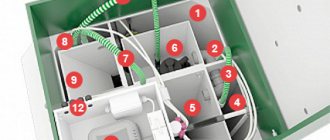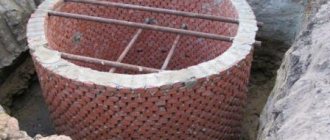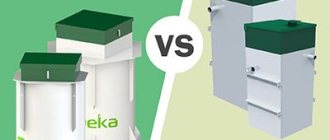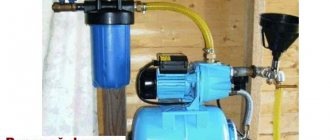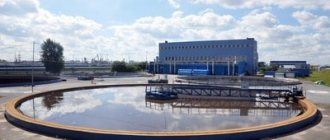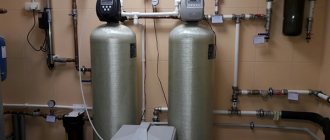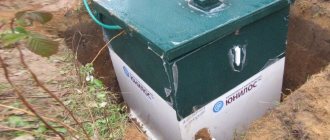Water disposal and wastewater treatment systems are an important part of the engineering support of any populated areas. However, if in cities the sewerage system is centralized, then residents of suburban cottage and holiday villages, villages and the urban private sector face a real problem with wastewater treatment. The issue of choosing a biological treatment station is very relevant, especially if there are a large number of manufacturers.
How to choose a water treatment plant that works well and meets the cost? To make a choice you need to answer two questions:
- What is the main disadvantage of budget treatment plants and septic tanks?
- Why does VOC best meet people's immediate needs?
The most budget-friendly sewerage option is local treatment facilities that use natural soil to filter through a filtration well, pre-accumulating and settling wastewater in a receiving well. A popular and inexpensive option is a reinforced concrete septic tank with several wells. However, the main question is: do such structures meet modern environmental requirements?
The disadvantage of budget treatment plants is the risk of contamination of soil and underground aquifers, which transfer the results of wastewater over long distances and large areas.
A reinforced concrete septic tank can only be used in places where the groundwater is quite low. At the same time, the useful volume of such septic tanks is calculated from the level (mirror) of the water to the bottom of the supply sewer pipe.
Selection and comparison of biological wastewater treatment plants
Taking into account the problem of soil pollution, it is important to use biologically active structures that are equipped with devices that ensure destruction (purification) processes using bacteria grown in anaerobic and aerobic conditions.
There are quite a lot of manufacturers of biological treatment stations. Therefore, it is very important not to make a mistake in choosing equipment. Let's take a look at several of the most popular manufacturers of local treatment facilities that use different methods of wastewater treatment. These are Unilon-ASTRA, TOPAS, Biolix company with LOS SPARTA, BIOzon stations, TVER, POBEDA. But first, let’s look at the important criteria for the consumer that influence the choice of an autonomous sewer system for a country house.
Factors to consider when choosing a biological wastewater treatment plant
Performance is the first indicator required for selection. Depends on the number of users and is calculated based on the average water consumption of one person 200 liters per day. Thus, when five people live in a house, they choose a station with a capacity of 1000 liters per day.
A salvo discharge is a volume of wastewater produced simultaneously and in large quantities that a station can handle without the risk of washing out beneficial microflora or flooding the electrical compartment.
You can determine the salvo discharge by calculating the minimum one-time discharge of water when using the plumbing fixtures indicated in the table.
| Sanitary installation | Salvo discharge, l |
| Toilet | 10 |
| Sink | 10 |
| Bidet | 5 |
| Kitchen sink | 30 |
| Shower cabin | 90 |
| Standard bath | 200 |
| Jacuzzi bath | 400 |
| Corner Jacuzzi bathtub | 440 |
| Washing machine | 50 |
| Dishwasher | 20 |
Case configuration . The shape of the station can be vertical cylindrical, such as the station SPARTA, BIOZON, POBEDA, etc., horizontally, such as the station TVER, LEADER, or in the form of a parallelepiped, such as TOPAS, UNILOS, BIOXY, etc.
The cylinder-shaped body is more stable. The load acts uniformly on the walls of the cylindrical station. From the outside, the body experiences soil pressure, from the inside - the pressure of incoming wastewater.
Rectangular housings are tightened with clamps or equipped with stiffeners, for example, Unilos-ASTRA. This way they help the body to withstand water pressure from the inside.
Cylinders are cheaper to make and lighter than rectangular bodies, making them easier to install by hand.
Case material. The most durable and reliable cases are made from frost-resistant HDPE (low-density polyethylene), foamed polypropylene, and polyethylene. For example, TOPAS, Yunilos-ASTRA, Eurobion are made of PP (large wastewater treatment plants are also made of PE); SPARTA, POBEDA, etc. have casings made of HDPE. All these stations are made on automatic welding machines. Premium segment stations (SPARTA, BIOZONE) have additional reinforcement, as well as manually checked seams in hard-to-reach places. They don't allow marriage. Unlike fiberglass septic tanks, stations made of sheet HDPE do not have leaks at the necks and pipes.
HDPE housings can easily withstand the pressure of heaving soils, while housings made from other materials can be deformed during soil transformation under the influence of temperature changes.
Stability in the ground. An important characteristic that makes it possible to install the station in any soil. So, for example, Eurolos uses the upper ceiling or structural projections with angular lower lugs as a lug. The soil presses on the protruding platforms, theoretically preventing the station from rising upward. However, it is necessary to take into account the area of the protruding surface, the area of the station and the height of the column of soil that will put pressure on the station. In the TOPAS and Yunilos-ASTRA stations, the lugs act as lugs, which are intended for loading and unloading the station.
In SPARTA, the lugs are made in the form of a circular protrusion at the bottom, reinforced with gussets; they do not allow the station to be squeezed out when the groundwater level rises. The area of such ground hooks significantly exceeds the area of the corner bottom hooks at other stations.
| Rice. Station SPARTA, the picture clearly shows the lugs located at the bottom of the hull, reinforced with gussets | Rice. VOC Eurolos. The platform at the bottom of the station acts as a lug |
Design complexity . The simple design of the station is a significant factor that influences the choice. For example, in the design of a dual-mode Unilos-ASTRA, if there is one compressor, a voltage stabilizer is required. An electromagnetic valve operates through it, reacting to the float sensor for switching modes. But the sensor can easily get stuck, threads and other debris can wrap around it, and then the station will freeze in one mode. And this means worse cleaning. For comparison, the SPARTA station, there is simply nothing to break in its design. The most difficult thing in the design is biological reactors with cellular bioloading. All transitions between compartments, all other pipes and pipes have a diameter of 110 mm, which 100% prevents debris and other waste from getting stuck in them. Accordingly, the purification process does not stop under the conditions of any wastewater composition.
Price. This is probably one of the most compelling arguments. Skeptics like to claim that biological treatment plants are very expensive. However, let's look at what affects the price.
First of all, the design of the station guarantees uninterrupted operation and ease of use. Everything is very simple, even with the compressor turned off, some stations will work like a septic tank. Effluents can settle for three days. Suspended substances are not carried outside. The most acceptable option is the one that works on the “set it and forget it” principle. The documented guarantee for this is the possibility of hidden installation. No self-respecting manufacturer would make such a statement without knowing for sure. A reliable station is simply buried completely with a lid and put into operation.
User convenience is the most important justification for the price. And also:
- quality materials;
- clean water output without dirty waste;
- extremely rare service;
- no need for conservation and annual commissioning;
- possibility of hassle-free cleaning of debris;
- 10 year warranty, return guarantee without explanation (!);
- built-in UV disinfection unit (more relevant than ever today);
- 100% protection against flooding of the instrument compartment and electrical equipment, respectively;
- control the station from a smartphone through the Smart Home system, through the built-in iOS and Android applications.
These factors justify the stated cost of the station.
Buy a septic tank for permanent residents “Topas”
Septic tanks "Topas": wastewater treatment at no additional cost. Are you choosing a reliable, durable and economical septic tank for your home? Pay attention to Topas septic tanks, the price of which is determined by the technical parameters and the complete set of treatment devices.
They allow you to create conditions in your dacha or country house that are comparable in comfort to living in a city apartment. We offer to buy Topas septic tanks, which effectively clean household wastewater and perform their functions without regular pumping. Thanks to the variety of models, you can choose an option with the desired performance for permanent or seasonal use.
Treatment technology and design features of modern VOCs
Biological treatment stations consist of several compartments. Only in some places it is a receiving chamber, and in other models it is a primary settling tank, which operates on the principle of a septic tank.
For example, wastewater treatment technology in modern stations occurs while it is still in the primary settling tank. The water is purified by 80%. The impurities in the settling tank settle and the formed ecosystem of anaerobic bacteria begins to operate. And the sump tank, acting as an anaerobic septic tank, retains fats, toilet paper, garbage, etc. Although, in some stations, for example, in TOPAS, fats clog all working areas and are practically not processed; after a couple of years they turn them into useless and non-functional structural elements.
If you look at the SPARTA station, the first chamber, which occupies 50% of the total volume of the station, is anaerobic, the second and third compartments with bioreactors are aerobic devices. In them, the vital activity of bacteria is supported by oxygen pumped by a compressor. Which, at the request of the customer, can be installed directly in the station, in a separate room, or in the house, or mounted in a separate box for the compressor. Which is especially convenient when the SPARTA station is completely hidden.
Thus, a modern treatment plant is a single block of combined type tanks.
Traditional definition of cleaning technology for most local facilities
The passport documents for many deep biological treatment stations provide the following description of the technology. For example, the work of Unilos-ASTRA is based on the treatment of wastewater due to the biocenosis of attached and free-floating autotrophic and heterotrophic microorganisms operating under aerobic and anaerobic conditions with automatic maintenance of the concentration of activated sludge in the aeration tank, followed by post-treatment and disinfection processes.
For reference. What are heterotrophic and autotrophic microorganisms? These are bacteria that use organic substances and food waste from human and animal life for their nutrition.
That is, everything that is contained in sewage water.
The main proven advantage of a biorefinery station with an anaerobic receiving compartment is that the technology of preliminary anaerobic treatment in the settling tank helps reduce biomass by about 10 times compared to aerobic treatment and contributes to the production of biogas. Solids accumulate at the bottom. The practical advantage of the anaerobic process in the settling tank is that additional purification occurs through deep removal of nutrients in combination with subsequent aerobic processes.
The settling tank of the SPARTA biostation occupies half of the total volume of the station, the rest of the space is allocated to two chambers with bioreactors. The overflow from the septic tank occurs at the level of the outlet pipe. That is, the bottom of the overflow and outlet pipe is at a height of 165 cm, on the same level. It's very high. It is the height that ensures the settling of solid dispersed impurities.
Some details about the bioreactor
For example, SPARTA bioreactors are located in the second and third compartments of the station. They are the most modern type of modified aeration tank with a submersible membrane filter in which attached microflora is cultivated. It is a BIO download. The biocenosis or bacteria are grown directly in the bioreactor and do not require external additives. Membranes make it possible to reduce the size of the bioreactor due to the concentration of activated sludge. Long-term wastewater treatment and concentrated biocenosis are the most important technological factors that affect the efficiency of treatment.
| Rice. SPARTA station, placement of two bioreactors. Location of taps: on the left there are two taps - one for supplying air to the bioreactor, the second to the airlift. The air duct then splits into two lines and each goes to its own bioreactor. The taps are made of plastic, which is important, there is no metal in the design, which means there will be no corrosion or destruction of the metal. | Rice. And this is what the compartments look like in the EuroLOS Bio station. |
BIO-loading is a way to resist chemical processes, volley discharges and promote the growth of bacteria in large quantities.
The bioreactors are located in the second and third chambers, with an overflow between them at a height of 165 cm at the bottom of the pipe. Bacteria obtained from human and animal waste do not float throughout the aeration tank, but accumulate, feed and live in the membranes of the bioreactor. Why do you need a third camera?
With the presence of a third compartment, the developers:
- firstly, we implemented a water circulation mode;
- secondly, they created conditions for the preservation of sludge.
The third compartment is a quiet zone for the wastewater, in comparison with the second zone, where in the aeration tank the wastewater is purified by oxygenated bacteria; in the last chamber, the wastewater settles and calms down before being discharged outside.
As a result. The bioreactor in which the biocenosis is concentrated is an important technological factor that affects the efficiency of VOCs and the duration of wastewater treatment.
Conclusion from the design description:
The design of the SPARTA and POBEDA stations implements a combination of an anaerobic primary settling tank and aerobic chambers of bioreactors with flow-transverse modules. Colonies of aerobic bacteria are concentrated in the bioload; their vital activity is supported by air supplied by the compressor. That is, bacteria are fixed in most modern stations. Although in some models, like in the TOPAS station, microorganisms are in a suspended state, practically floating freely. When chemicals enter the station, most bacteria die.
Service recommendation
If necessary, the bioreactors can be removed and washed. This is an important design feature; it facilitates self-service of the VOC. This can be used, for example, during a power outage, when the station switches to septic tank mode, or when blockages occur in the pipes and cleaning is required.
Installation
Installation work is carried out in the following order:
- A pit is dug according to the size of the station. If necessary, with a reserve for insulating the structure.
- A concrete slab is laid on the bottom. A biological treatment station is placed on top of the slab. The body is secured with straps.
- The pipes are connected to sewerage and wastewater drainage networks. Electrical installation is in progress.
- The installation is filled with water. Covered with soil.
System installation may depend on the type of installation or model, natural factors, location, etc.
Important! If the inlet pipe supplying wastewater to the system is installed above the freezing point of the soil, the station may fail.
Ultraviolet purification
Sanitary requirements in some cases require the installation of an ultraviolet cleaning unit. Some manufacturers offer their purchase separately, while others, for example, Biolix, included the unit in the total cost of the SPARTA station. Some people purchase an ultraviolet after-treatment unit separately and cost about 70 thousand rubles. or it doesn't exist at all. However, with new environmental standards, UV post-treatment is a mandatory condition in order to be able to drain water into a roadside ditch.
Energy dependence is an enemy you can fight
However, is it always possible to support the vital activity of microorganisms? Power outages and lack of oxygen at most stations for 72 hours cause the death of microorganisms. This happens faster in winter.
When the power goes out, modern bio-treatment facilities become a regular septic tank with two or three days of settling. The design feature of such equipment is that the inter-chamber overflows are located at the very top, at the exit level. This means that helminth eggs will not get into the second and third chambers even with two or three daily volumes.
Large selection of septic tanks at Capacity-Online
In our store you can choose and buy a septic tank for your dacha and for a large country house. The model is selected based on the number of people permanently living in the house. As a rule, this is the number that is indicated immediately after the name. If you plan to use a large number of plumbing points or frequent presence of guests, then it is recommended to take a larger volume.
Comparison of several local biological treatment plants from some significant manufacturers
A comparative analysis of existing aeration installations, although necessary, is very thankless. This work is almost like a dissertation. But the main principle on which the work of deep biological treatment stations is based is similar in nature. We talked about the cleaning technology and design features above. That's why.
In order to have a more or less complete picture, let’s consider the technical characteristics of biological treatment stations that are most in demand on the market: Biolix companies with SPARTA stations, NEP-center with Eurobion, Topolek-EKO and TOPAS stations, SBM-group with Unilos station, Engineering equipment with TVER station, SEC with BIOzone. The table presents the parameters and features of the most popular VOC options among users.
| Options | Biolix Sparta 1000 plus | Eurobion Eurobion-5 | Topas TOPAS-5 | Unilos Unilos-5 ASTRA | Tver Tver-1 | Biozone BIOzon-6 |
| Material and shape of the station Advantages and disadvantages | Low-density polyethylene cylinder | Cylinder Polypropylene | Parallelepiped Integral foamed polypropylene | Parallelepiped Integral foamed polypropylene | Elongated square shape with a semicircular bottom | Cylinder Polypropylene |
| Manufacturer's warranty for how many years | 10 years, electrical equipment - 1 year | 3 years for housing, 1 year for electrical equipment | 3 years warranty without contract. 5 years warranty with contract. | 5 years | 10 years, electrical equipment - 1 year | |
| Performance | 1000 l/day. | 900 l/day. | 1 m3 per day | 0.8 m3/day 250 l/day. | 1000 l/day. | 1.5 m2/day |
| Number of people | 1 – 5 | 1 – 5 | 1 — 5 | 1 – 5 | 5 – 6 | 1-6 |
| Overall size | 1860 x 2400 | 1.0x1.0x2.28 (m) | 1.12x1.12x2.36 | 2.450x1.1x1.67 | 1500x2600 | |
| Working part volume | 3530 l. | 3.2 m2 | ||||
| Hidden placement | Yes | No | No | No | No | No |
| Restrictions on the discharge of household waste, such as: napkins, food waste, chemicals, garbage | No. The first chamber is a settling chamber, garbage does not enter the bioreactors and exit accordingly | The first chamber is a surge tank where the aeration filter and airlift are located. Debris can clog overflow tubes | Perforation and side airflow, high risk of clogging | Perforation and side airflow, high risk of clogging | There is no filter for coarse fractions. Low chance of clogging | Dumping of large waste is prohibited. |
| Energy dependence | A power outage does not affect system operation. Anaerobic digestion works in septic tank mode. The bacteria are alive for up to 3 months. Electrical equipment is accessible and does not require maintenance | Energy-dependent installation. Ability to recover from power outages (more than 10 hours) only after maintenance | Volatile installation. Ability to recover from power outages (more than 10 hours) only after maintenance | Energy-dependent installation. Ability to recover from power outages (more than 10 hours) only after maintenance | Conditionally not volatile. Ability to recover from power outages—immediately | Energy-dependent conditionally, the receiving chamber is anaerobic. Recover immediately after a power outage |
| Winter use of the system Seasonal use of the system | Seasonal and year-round use. | Year-round use only | Year-round use only | Year-round use only | Seasonal and year-round use | Seasonal and year-round use. |
| Volley discharge, after draining from a bathtub or washing machine | Limited only by the volume of the station (Sparta has 1000 plus = 3530 l) | 390 l. | 220 l. | 225 l. | 225 l. | Restrictions only on volumetric station |
| Degree or quality of cleaning | 98% | 98% | 98% | 98% | 95% | 98% |
| Entering drain cleaning mode | 2-3 days after launch | Up to a month after launch, subject to all operating conditions | Up to a month after launch, subject to all operating conditions | Up to a month after launch, subject to all operating conditions | On average a week after launch | 2-3 days after launch |
| Discharge of purified water | Gravity, forced, combined (universal) | Gravity, forced | Gravity, forced | Gravity, forced | Gravity, forced | Gravity, forced |
| Possibility of self-service | Yes | Yes | Conditionally yes | Conditionally yes | Conditionally Yes | Yes |
| Difficulty of maintenance | Low | Low | Average | Complex 1 time in 3 months, built-in pump for pumping out sludge | Low | Low |
| Maintenance frequency | Once every three to seven years | Semiannually | Once every three months | Once every three months | 1 time every 3 months 1 time per year call for a vacuum cleaner | Once every 5 years, call a sewer truck |
| Number of cameras | 3 Overflow circulation due to three chambers | 4 Circulation with 3 pumps | 4 Circulation with 3 pumps | 3 | 2 | |
| Number of compressors | 1 | 1 | 2 | 1 | 1 | 1, and one airlift pump |
| Placement and replacement of compressors | In the station itself, in a house or a separate box buried in the ground | At the station | There is no solenoid valve in the station itself | In the station itself, replacing a compressor with a solenoid valve | In the station itself, in a house or a separate room | At the station |
Conclusion.
We hope that after reading the article, the user will make the right choice and decide for himself which biological treatment station is most suitable for him.
Now, putting aside the technological details, we can say that you need to choose the station that does the following:
- the station's sealed housing does not require special anchoring;
- maintains operation for a long time without power supply, at least for several days;
- without maintenance, it switches to septic tank mode, which copes with the uneven flow of wastewater;
- enters operating mode in the shortest possible time;
- will be able to more or less effectively fight fats and does not allow helminths to leave the primary settling tank with anaerobic bacteria into the second and third chambers;
- can withstand the calculated salvo release of water;
- does not require frequent maintenance, and if necessary, the owner himself can carry out flushing or simple maintenance of the station;
- does not need to frequently call a sewer truck.
Purchase and ease of use of a septic tank
This page presents septic tanks “Tver”, “Ergobox”, “Onyx” and others. Each of them is effective, strong and durable; if used correctly, they can last up to fifty years.
A high-quality country septic tank without pumping is:
- effective water purification up to 98%. Such water can be discharged into a natural reservoir if you do not need it for irrigation;
- high strength of the body, thanks to which the septic tank can be installed even on an area with dense rocky soil;
- complete absence of stench, since microorganisms in the septic tank do not emit ammonia during their life processes;
- Easy maintenance - sludge only needs to be removed once or twice a year.
Call us today - we are always ready to accept your order for the delivery and installation of a deep cleaning septic tank.
How to choose the most suitable system volume
Modern manufacturers create local stations with different volumes. Drainage pumps and an automatic control system can also be additionally installed. The buyer can choose the material from which the tanks will be made.
To select the most suitable volume, consider the following parameters:
- The number of people who will live in the house. It is also necessary to make allowances for a possible increase in people. For example, the arrival of relatives, the celebration of significant numbers, the replenishment of the family. More people place additional stress on the sewer system, which is why it should be made a little larger.
- Water consumption should include using the toilet, shower or bath, washing dishes, cleaning the premises, and doing laundry. On average, following some regulatory documents, from 200 liters to 300 liters of water are consumed per person per day. With installed filters, consumption increases, but not by a large figure, since each family member consumes only a few liters per day.
- Multiply daily water consumption by the number of people living. In this case, it is necessary to take the maximum parameters. For example, in a family of three people, the total water consumption per day will be 900 liters. This is enough for a comfortable stay without constant savings.
- When choosing a tank, you should know that its volume should exceed the daily consumption several times. Therefore, if the user expects to consume 900 liters of water per day, the volume of the tank should be at least 4 m3. This is quite enough for the system to function properly without failures.
The volume of the system should be selected in advance, having carried out the necessary calculations. If the local treatment station is too small, this will lead to interruptions in operation. The consequence of cessation of functioning is that the time period during which beneficial microorganisms are restored is too long. The device begins to work, deviating too much from the passport data, which leads to more frequent breakdowns.
Preparing the station for wintering
Preservation of an autonomous sewer system for the winter period is mandatory if the local system is not planned to be used during the cold season. It includes several operations.
First of all, the installation is de-energized, after which the electrical equipment is removed from it for subsequent storage in a heated room. We are talking about a compressor and a drain pump, if one is implied by the design. The next step is to pump out the contents of the sludge stabilization module and the aeration tank to a depth of approximately 0.5 meters from ground level. It is also necessary to check the water level in the receiving chamber, however, if the installation is operating correctly, it does not need to be pumped out. In order to protect the walls of the chambers from possible damage when the liquid freezes, containers with sand are lowered inside the chambers. Sheets of polymer insulation (made of polystyrene foam or polyurethane foam) are attached to the outer parts of the station, which are subsequently covered with film.
Smart 10 LONG PR
In the rating of septic tanks, “smart 10” has established itself as a quality product. On top of it there is an electric box, at the bottom there is an aeration membrane for splitting all fractions. There is a second bottom. At the bottom of the partition there is an overflow hole through which 2 vessels communicate. The grease trap collects the top film of water (scales, seeds).
After 3 months or 1 year you need to undergo service maintenance.
The total productivity of “Smart 10” is 2 cubic meters.
Environmental pollution problem
Water is life, but we consume it clean and return it dirty. If the drains are not cleaned, then the time of “precious moisture” described by many science fiction writers will come very soon. Nature can purify water on its own, but these processes proceed very slowly. The number of people is increasing, the volume of water consumption is also increasing, so the problem of organized and thorough wastewater treatment is especially acute. The most effective water purification technology is biological. But, before considering the basic principles of its operation, you need to understand the composition of water.
CRITERIA FOR SUCCESSFUL BIOPROCESSES
Since biological methods are based on the vital activity of the microbial mass, special attention must be paid to the environmental conditions in which the formation of new cells occurs: pH and temperature, the presence of toxic substances, the presence of nutrients.
The optimal temperature for a successful process is considered to be 12-30 0C, pH 6.5-8.5. If these ranges are violated, a decrease in the rate of sedimentation of sludge flakes is observed, as a result of which the biocenosis is removed, which, in turn, negatively affects the quality characteristics of the purified liquid and leads to an increase in the humidity of sediments unloaded for fur dehydration. For effective removal of contaminants and their assimilation by a set of microorganisms, wastewater must necessarily contain elements such as nitrogen and phosphorus in concentrations adequate to the quantitative characteristics of the indicator characterizing the biochemical oxygen demand (BOD). If the biocenosis is not provided with this recharge, its sedimentation ability and bioactivity decreases.
The greater the difference between the ratio of chemical and biochemical oxygen requirements, the higher the presence of industrial impurities in the treated liquid, which also indicates an increase in water toxicity. Toxicants include: heavy metals, surfactants, petroleum products.
Therefore, before carrying out the biological stage of purification, if there is a significant content of the above substances, it is advisable to organize local pre-treatment in special devices - oil-oil traps and horizontal or vertical settling tanks with treatment with reagents, such as milk of lime or soda.
Buy a turnkey septic tank "Eurolos Bio"
Septic tank "Eurolos": effective autonomous sewage system for a summer house or country house. Do you want to purchase a good country septic tank that will provide effective treatment of household wastewater and is designed for intensive use over a long period of time? From us you can buy a Eurolos septic tank from the manufacturer, choosing a model taking into account the number of users, the characteristics of the site and other factors. With the help of a septic tank, the price of which depends on its performance, you can create comfortable conditions in your dacha or country house. The country septic tank provides high quality wastewater treatment, confirmed by certificates obtained in accordance with the legislation of the Russian Federation. and others (22 items in total). The models are similar in operating principle and show high performance. High quality workmanship guarantees a long service life of the equipment and its trouble-free use. The price of a septic tank depends on the brand and chamber volume.
Chemical
The essence of chemical methods is the management of special substances. When neutralizing acids and alkalis, special reagents are introduced (lime, ammonia), and when carrying out oxidation, various oxidizing agents (potassium permanganate, gaseous and liquefied chlorine) are introduced.
This eliminates toxic compounds. These measures are resorted to in order to eliminate soluble substances in closed water supply systems.
Basic physical and chemical methods
When carrying out physical and chemical methods, impurities of inorganic origin are eliminated and impurities of organic origin are destroyed.
These include the following methods:
- Flotation. Air is passed through the wastewater. Gas bubbles capture surfactants, oils and a number of other contaminants, forming a foam-like layer on the surface that is easily removed;
- Coagulation. This method involves the introduction of coagulants (for example, ammonium or copper salts) in order to form sediments in the form of flakes, which, like the foam layer, can be easily removed;
- Sorption. Using this technique, valuable soluble substances are extracted for further disposal. To carry it out, substances that can absorb contaminants (for example, silica gel or activated carbon) are used.
Definition
Wastewater and its brief characteristics.
In practice, the definition of urban wastewater is used. As a rule, these are domestic and industrial waste mixtures. As for domestic, industrial and atmospheric wastewater, they can be disposed of together or separately. More popular are all-alloy and separate drainage designs. For a common alloy system, it is not a problem to transport any type of wastewater through one network of pipes outside the city to a treatment facility. Separate systems include various pipes and channels: one can drain rain and uncontaminated industrial liquid, and the other can carry household and contaminated liquid.
Wastewater is a complex heterogeneous mixture containing different compounds (organic and mineral). As a rule, their states are undissolved, colloidal and dissolved. The level of wastewater contamination can be assessed using concentration. In order to develop a rational water disposal scheme and assess the possibility of reusing water, it is necessary to become familiar with the composition and regime of water disposal.
The efficiency of fluid application in an industrial company can be assessed using the amount of recycled water used, the utilization rate and the percentage of losses.
For an industrial company, it will be necessary to draw up a water balance, which includes the costs of losses, discharges and compensating flows of liquid into the system. The design of a newly constructed or reconstructed sewerage system for a populated area and an industrial company must be carried out using duly approved economic development schemes.
ECOLOCA 4 PR
The biostation combines gravity, forced release, which is immediately installed for customers to order. A septic tank for a private house is designed for 3 people. For those who install it themselves, the manufacturer makes a special pipe for areas where there is no sewerage yet or where it is possible to plan it so that the pipe fits the diameter.
Additionally, the insertion zone has already been marked (for those who install it themselves). The bioseptic tank arrives ready-made (all wires are connected and it’s ready to go). The system minimizes the amount of electronics, which helps it last a long time. In case of flooding, nothing bad will happen (all control is carried out from the house with a package of switches). The sockets are waterproof. The solenoid valve can be removed. Maximum discharge 180 l, maximum power 800 l.
The “Ecoloca” body is made of plastic with a thickness of 10 mm, which is why the thermal conductivity coefficient there is zero.
The set includes an emergency warning light in the form of a light bulb.

